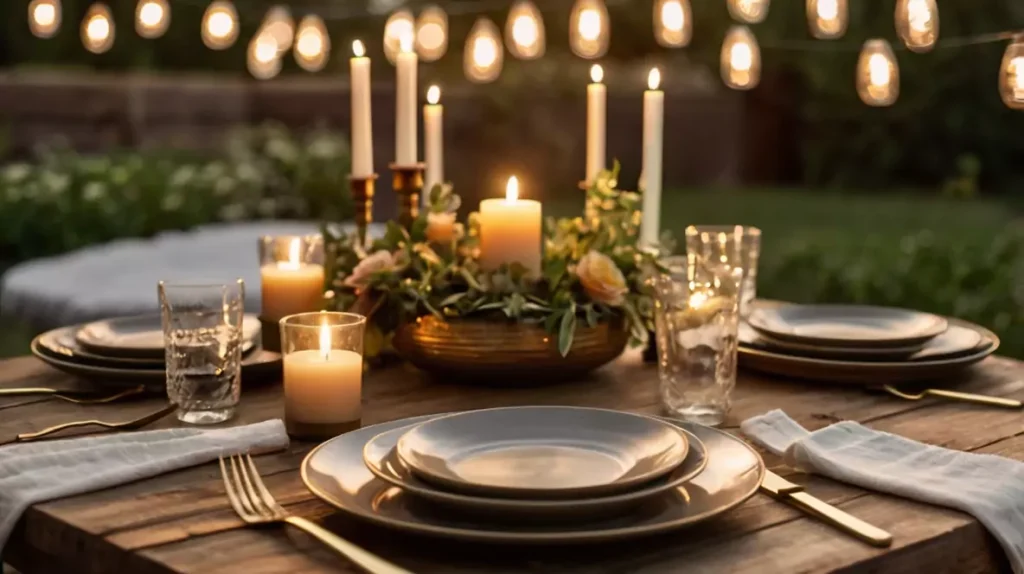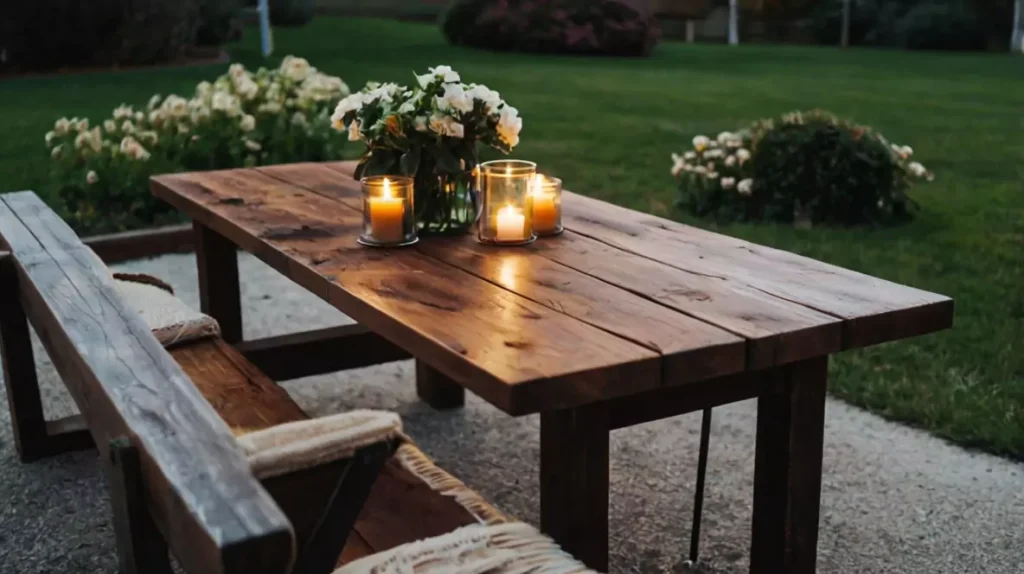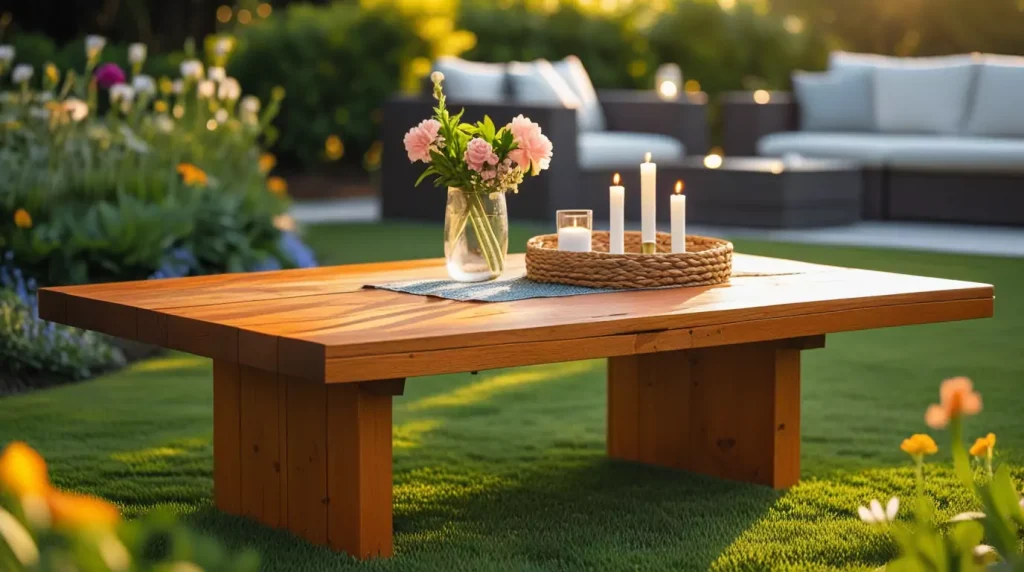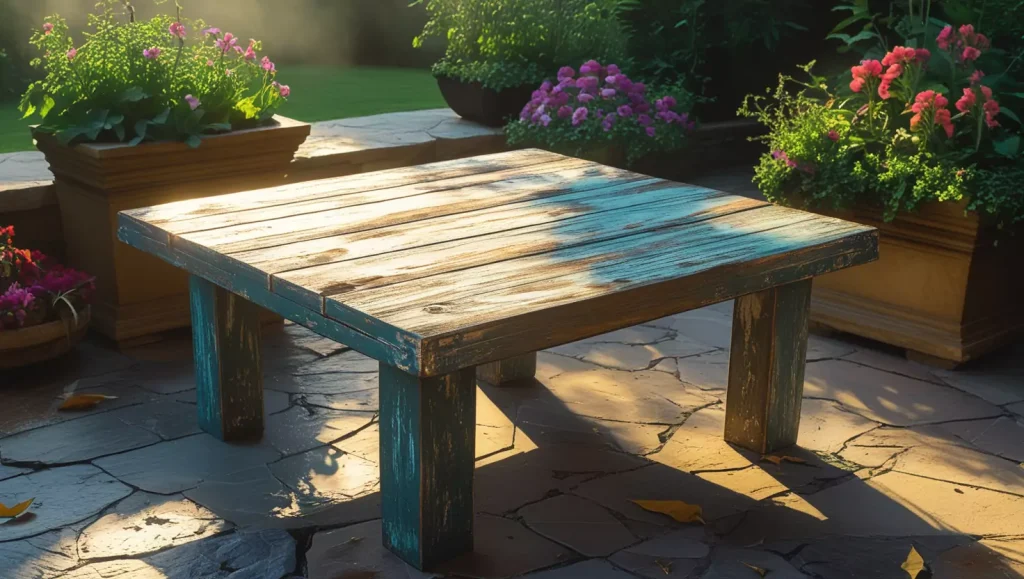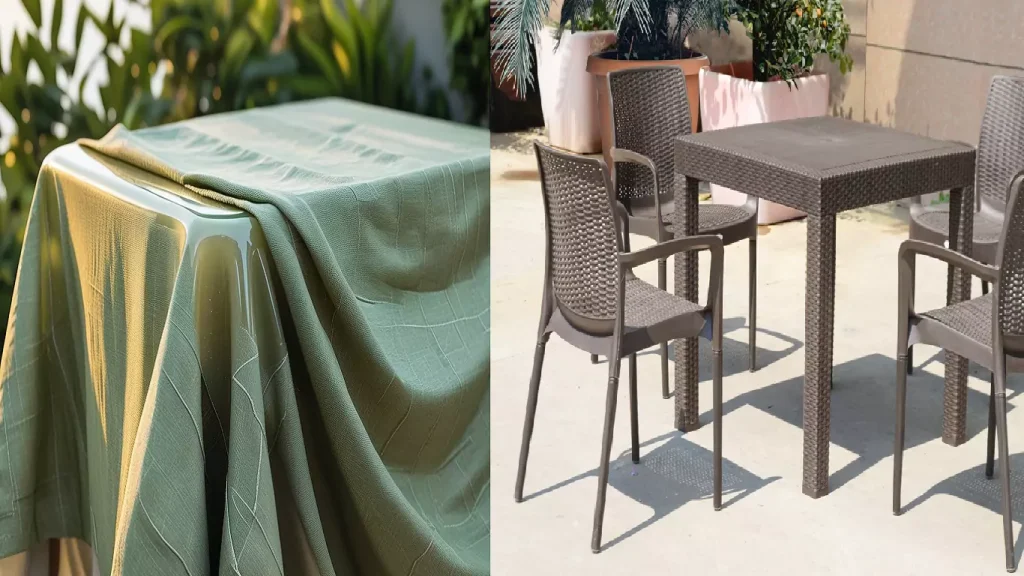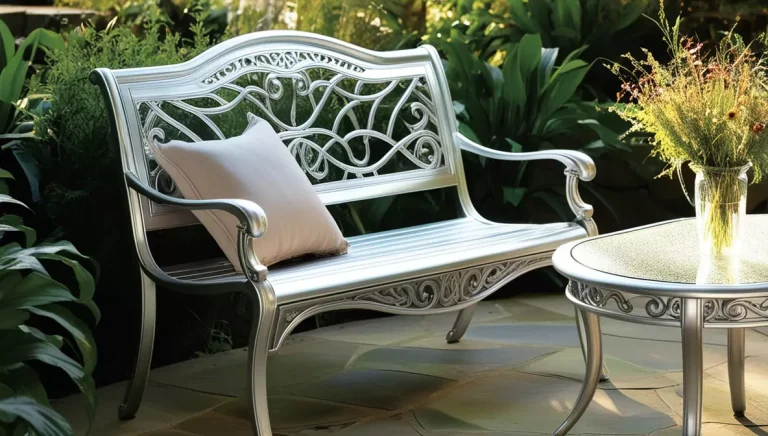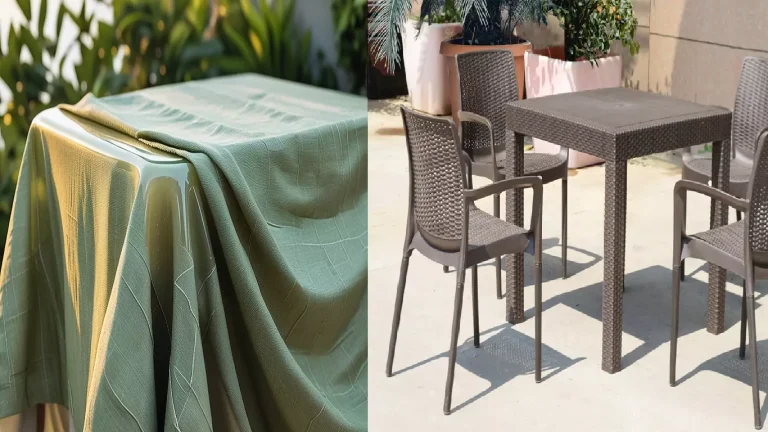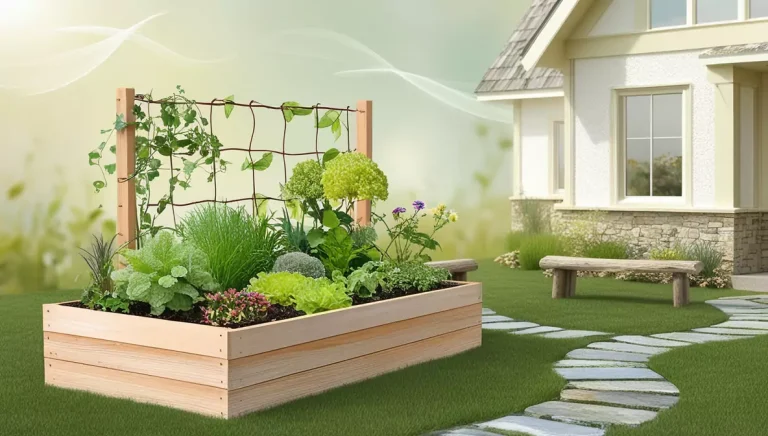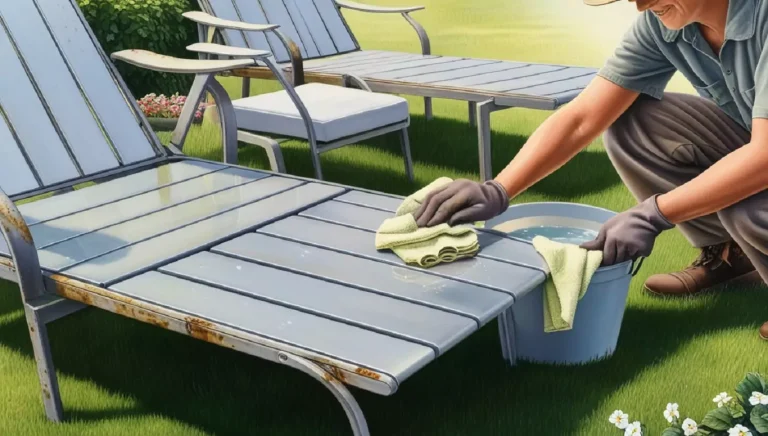What experts Recommend On Cheapest Wood for Outdoor Furniture Use?
When getting outdoor furniture, finding an affordable yet durable option is a challenge. For many, the search starts with identifying the cheapest wood for outdoor furniture that can handle outdoor conditions without breaking the bank.
Price is significant, but so are the wood’s lifetime, care requirements, and durability.
Pine
Pine, the cheapest wood for outdoor furniture. Pine’s affordability stems from its availability and the fact that it is a softwood, making it easier to process than hardwoods. Pine is also lightweight, which makes it popular for various woodworking projects, including outdoor furniture.
However, not expensive but pine is not durable option. The natural oils that shield other types of wood from insects and decay are absent from pine.
When Pine Works for Outdoor Furniture
Pine can still be a good option for certain types of outdoor furniture. For example, pine works well in covered outdoor spaces, such as patios or gazebos, where it’s not exposed to harsh elements like rain and direct sunlight. It can also be treated with protective coatings to enhance its durability. Applying weather-resistant finishes or sealants can extend pine’s lifespan outdoors.
Additionally, pine is ideal for smaller projects like garden benches or plant stands. Unlike dining tables or lounge chairs, which are larger pieces of furniture, these items might not need to be as durable.
Factors Affecting Wood Prices
Before diving into other wood types, it’s important to understand what impacts wood prices. Several factors play a role:
- Supply and Demand: This economic principle heavily influences wood prices. When wood is in high demand and there’s a limited supply, prices increase. This often happens when construction booms or when natural disasters damage large amounts of trees, reducing available stock.
- Quality: High-quality wood is often more expensive. Wood with fewer knots, a better grain pattern, and less moisture content usually costs more because it requires less processing and looks better.
- Processing Costs: Harvesting wood is just the beginning. Cutting, drying, and treating wood all add to its price. Wood must often go through various processes before being ready for furniture production.
- Transportation Fees: Wood must travel from the forest to the sawmill and then to manufacturers and retailers. These transportation costs are passed along to the consumer, especially for wood sourced from distant regions.
- Environmental Regulations: Sustainable logging practices can also increase the cost of wood. Governments worldwide enforce strict regulations to protect forests, which can limit the supply of certain wood types and drive up their price. Certified sustainable wood is often more expensive than non-certified alternatives, but it’s better for the environment.
Beyond Pine: Alternatives for Outdoor Furniture
While pine may be the cheapest wood, other types of wood offer better durability, aesthetics, and resistance to the elements.
Cedar
Abilities of naturally resists insects and weather resistance make Cedar popular. Its aromatic oils repel pests, and it weathers beautifully over time, turning into a silvery-gray color when left untreated. Cedar is not just portable but also light.
Cedar is not the cheapest wood, but it offers excellent value. It costs more than pine but is cheaper than premium hardwoods like teak. It requires less upkeep and lasts longer outside due to its resilience to degradation. In order to maintain its longevity and beauty, cedar furniture usually just needs to be cleaned and oiled occasionally.
Since cedar is a softwood, dings and scratches are common However, these minor flaws don’t affect its structural integrity. If you’re looking for an affordable wood that lasts long in outdoor settings, cedar is a fantastic choice.
Cypress
Cypress is another excellent option for outdoor furniture. It is ideal for furniture exposed to moisture and rain since it is extremely resilient and naturally resistant to deterioration. Like cedar, cypress contains natural oils that protect it from insects and fungi.
While cypress can be more expensive than pine, it is still relatively affordable compared to premium hardwoods. Cypress’s longevity and low maintenance needs make it a cost-effective choice for outdoor furniture.
Another advantage of cypress is its beautiful grain and light color, which can be stained or left to weather naturally. Its appearance adds a rustic charm to outdoor furniture, making it a popular choice for garden benches, chairs, and picnic tables.
Fir
Another reasonably priced choice for outdoor furniture is fir wood. For carpenters, Fir is a favored because of its straight grain and ease of labor. It is strong and durable, and while not as naturally rot-resistant as cedar or cypress, fir can still be used for outdoor furniture if treated properly.
Fir is cheaper than cedar and cypress, making it a budget-friendly choice for those looking for more durability than pine offers. You can use fir for outdoor projects like garden benches, pergolas, or gazebos. Just be sure to seal or paint fir furniture to protect it from the elements.
Poplar
Poplar is another inexpensive wood option often used for indoor furniture and cabinetry. While it is cheap and easy to work with, poplar is not naturally resistant to rot or insects. For this reason, it is not the best choice for outdoor furniture unless treated with a protective finish.
Because poplar is so easily painted, it can be used to create ornamental exterior pieces. However, if you live in an area with heavy rainfall or high humidity, poplar may not hold up well in the long run. Still, if you’re looking for a low-cost option for covered outdoor areas, poplar is worth considering.
Redwood
Redwood is a high-end wood that is famous for strength and looks. Its natural resistance to degradation and insects makes it ideal for outdoor use. Redwood is very lightweight, which makes moving furniture around the yard easy.
Although redwood is more expensive than pine or fir, it is cheaper than premium woods like teak or mahogany. Redwood is a great option if you want outdoor furniture that will last for a long time with little upkeep. Redwood furniture can last for decades if properly cared for, and it requires very little maintenance beyond occasional cleaning.
Let’s see some terms people search for in most platforms
Cheap Wood for Outdoor Furniture
Durability and weather resistance are important considerations when selecting the cheapest wood for outdoor furniture. Wood that can withstand outside conditions without sacrificing quality is what you need. Thankfully, there are affordable options that strike a mix between price and usefulness. Let’s examine the top inexpensive woods and the reasons they are suitable for outdoor use.
Cypress
Want a best and cheapest wood for outdoor furniture, choose cypress. It resists deterioration naturally and is long-lasting. This wood is perfect for damp locations since it has natural oils that shield it from moisture and insects. Cypress is less expensive than teak or mahogany, yet it still performs well over time. Because it is lightweight, it is very simple to use for do-it-yourself projects.
Western Red Cedar
Another excellent choice for affordable patio furniture is Western Red Cedar. It is ideal for outdoor application due to its natural resistance to decay and light weight. The warm, rich hue of cedar gives any patio a lovely appearance. Many homeowners like how it weathers into a silver-gray hue over time. Insects are repelled by cedar’s unique scent, which increases its resilience in outdoor settings.
Pine
People like pine as outdoor furniture material. Because it’s soft and easy to work with, do-it-yourselfers will love it. Pine, however, needs routine care to avoid decay and insect damage. If left untreated, it is not very resilient to severe weather conditions. A good weather-resistant stain or sealant can extend its lifespan significantly.
Cheapest Water-Resistant Wood
If you’re looking for water-resistant wood that won’t break the bank, there are several options to consider:
Cypress
Because of its inherent moisture resistance, cypress is a great wood for damp settings. It is among the best and cheapest wood for outdoor furniture in wet areas since it can tolerate exposure to water without decaying.
Larch
Another reasonably priced wood that resists water well is larch. For outdoor furniture that must endure inclement weather, its strength and durability make it perfect. Additionally, the distinctive grain pattern of larch lends flair to your outdoor area.
Robinia (False Acacia)
If you need weather friendly wood, get False Acacia of Robinia. It is appropriate for outdoor furniture since it is strong and has a respectable level of moisture resistance. Even though it’s less popular than cypress, it’s still a decent choice for homes on a tight budget.
Cheap Lightweight Wood for Outdoor Furniture
Your furniture may be easier to move around if it is made of lightweight wood. Take into consideration these choices if you require anything that is inexpensive and simple to work with:
Poplar
Poplar is a lightweight, soft wood that is frequently used to make low-cost outdoor furniture. It’s ideal for do-it-yourself tasks because it’s simple to shape and work with. If not properly handled, it isn’t the most resilient choice for prolonged outdoor use.
Balsa
Balsa is incredibly lightweight and inexpensive. Although it’s frequently used for do-it-yourself projects, it’s not the best option for outdoor furniture. It is not a good option for prolonged weather exposure due to its lack of durability. However, it’s perfect for temporary or indoor-outdoor furniture that won’t face harsh conditions.
Cheapest Outdoor Wood Furnace Options
Although outdoor wood heaters usually use durable materials, there are some less expensive solutions available:
Steel
Compared to other materials like cast iron, it is less costly while yet being sturdy and long-lasting. Although steel furnaces have a long lifespan, it’s crucial to make sure they’re adequately coated to prevent rust.
Brick
If you’re building your own outdoor wood furnace, brick can be a cost-effective choice. With the correct design, you may build a long-lasting and effective outdoor heating furnace out of cheap bricks.
Worst Woods for Outdoor Furniture
Not every type of wood is appropriate for outdoor use. When exposed to rain, sunshine, and insects, certain varieties may not perform well. When selecting inexpensive wood for outdoor furniture, steer clear of these types:
Pine
Pine is inexpensive, but without routine care, it is vulnerable to decay and insect damage. The Pine must be completely sealed before being used outside, but even with this protection, it could not last as long as more resilient woods.
Maple
When exposed to outdoor circumstances, maple tends to bend and lacks natural moisture resistance. It works best with sheltered outdoor spaces or interior furnishings.
Birch
Birch is not a good material for outdoor furniture. Its susceptibility to dampness and insect attack can accelerate its breakdown. Even though it’s inexpensive, it won’t withstand outdoor conditions well.
Options for Low-Cost Wood Patio Furniture
You require wood patio furniture that is long-lasting, weatherproof, and affordable. Here are a few excellent options:
Cypress
Cypress is a great choice for the least priced wood for outdoor patio furniture. It provides a great mix of cost and durability.
Pine
To keep it rot-free and in good condition, though, it needs routine care. Applying sealants and protective finishes can extend its life, making it a good option for budget-conscious homeowners.
Redwood
Redwood is more expensive than pine but less expensive than premium hardwoods like teak. It is safe from rot and insects. Additionally, redwood has a stunning, deep hue that elevates any outdoor area.
Does Outdoor Furniture Still Use the Cheapest Wood?
Yes, many people still use cheaper woods like pine for outdoor furniture, especially when working on a tight budget. Pine remains a popular choice for DIY projects and temporary furniture that won’t face constant exposure to the elements. Its affordability and availability make it attractive for garden benches, plant stands, and furniture in covered areas like patios.
If weather-resistant finishes are not applied, it is vulnerable to warping, rotting, and insect damage. Even though less expensive woods are still frequently utilized, many customers choose more robust options when their furniture will be left outside for an extended period of time. Pine needs frequent care to withstand the weather, but those who are prepared to spend money on preventative treatments can extend its lifespan. Making the switch to more resilient wood eventually turns out to be a wiser long-term investment.
Do Carpenters and Wood Experts Recommend Cheap Wood?
Most carpenters and wood experts generally advise against using cheaper woods like pine for outdoor furniture that will be exposed to the elements. While pine is budget-friendly and easy to work with, it is highly susceptible to rot, moisture damage, and insect infestation, especially when left untreated.
Carpenters recognize that pine can be used in sheltered or temporary outdoor projects, but they often recommend more durable woods like cedar, teak, or redwood for long-term outdoor use.
These more durable woods are naturally resistant to decay, require less maintenance, and hold up better in various weather conditions. Pine, being a softwood, also tends to dent and scratch more easily than hardwoods, reducing its longevity.
While pine may work for less exposed areas, experts believe that investing in resilient woods will save money and time in the long run, making it a smarter choice for outdoor furniture.
Best Wood for Outdoor Furniture
Teak is the best wood to use for outdoor furniture if you can afford it. Teak’s natural oils make it incredibly resistant to water, insects, and rot. It can withstand harsh weather conditions without warping or cracking, making it perfect for long-term outdoor use.
Teak is one of the most expensive woods, but its durability and minimal maintenance requirements make it a smart investment. In contrast to other woods that require frequent treatment or painting, teak can be left untreated and will continue to last for many years. Over time, teak weathers into a beautiful gray patina, which many homeowners find appealing.
How to Pick the Best Wood for Furniture Outside
Choosing the right wood for outdoor furniture involves balancing your budget with your need for durability, aesthetics, and maintenance.
- Durability: If you live in a region with heavy rainfall or extreme weather, invest in a durable wood like teak, cedar, or cypress. These woods naturally resist decay, rot, and insects, reducing the need for regular maintenance.
- Maintenance: Some woods require more maintenance than others. For instance, pine needs regular sealing to prevent weather damage, while teak can be left untreated and will still last for decades.
- Aesthetics: The appearance of the wood is another important consideration. If you prefer a rustic look, woods like cedar, cypress, and redwood develop a natural weathered appearance over time. On the other hand, pine or fir can be painted or stained to match your desired look.
- Budget: Finally, your budget will largely determine the type of wood you choose. Pine is the cheapest, but investing in a more durable option like cedar or teak could save you money in the long run by reducing the need for replacement and repairs.
FAQs : Cheapest Wood for Outdoor Furniture
What is the most affordable outdoor wood?
A: The Pine is typically the least priced wood for outdoor furniture. Even though it is inexpensive and simple to handle, it needs routine upkeep to avoid decay and deterioration.
Which type of wood is most affordable for outdoor use?
A: For outdoor use, treated pine is among the least expensive types of wood. Treatment lengthens its lifespan by enhancing its resistance to rust, deterioration, and insect damage.
What wood should outdoor furniture be made of?
A: Outdoor furniture should ideally be made of durable, weather-resistant woods like cedar, teak, or cypress. Because of their greater weather resistance, these woods require less maintenance.
How can I make cheap wood last longer outdoors?
A: To protect the wood from moisture and UV rays, use weather-resistant coatings, paint, or sealants. Regular maintenance, including reapplying protective coatings, will also help prolong its life.
Are there other affordable woods suitable for outdoor furniture?
A: Yes, other affordable options include cypress, western red cedar, and treated pine. These woods offer better resistance to weather and pests compared to untreated pine.
What distinguishes treated wood from untreated wood?
A: Because treated wood has been chemically processed to stop decay, degradation, and insect damage, it is more suitable for outdoor use. Untreated wood is more susceptible to weather-related damage in the absence of these protections.
Can wood from indoor furniture be used for outdoor furniture?
A: Without the right care, using wood from indoor furniture for outdoor furniture is not advised. Rapid deterioration may result from indoor wood’s lack of resistance to moisture, UV radiation, and bugs.
How frequently should inexpensive outdoor furniture be maintained?
A: Regular maintenance is essential. Depending on the wood and treatment, you may need to reapply sealants or paint annually or biannually to keep the furniture in good condition.
What are some signs that my outdoor furniture needs maintenance?
A: Look for signs like fading, cracking, warping, or splintering. These indicate that the protective finish is wearing off, and it’s time to reapply a sealant or paint.
Can I DIY with cheap wood for outdoor furniture?
A: Absolutely! pine and other affordable woods are easy to work with, making them great for DIY outdoor furniture projects. Just ensure you properly treat and maintain the wood.
Do the least expensive woods come in eco-friendly varieties?
A: Yes, using sustainably sourced pine or other FSC-certified woods can be environmentally friendly. Additionally, choosing woods that can be treated and maintained to last longer reduces the need for frequent replacements.
So Start With Balancing Cost with Longevity
When choosing the cheapest wood for outdoor furniture, pine is the most affordable option, but it may not provide the durability needed for long-term outdoor use. For those willing to spend a little more, woods like cedar, cypress, and redwood offer better resistance to the elements and require less maintenance over time.
Choosing the cheapest wood for outdoor furniture doesn’t mean sacrificing quality. Woods like cypress, cedar, and pine offer affordable options that can hold up well in outdoor conditions with the right care. Whether you’re creating benches, patio furniture, or an outdoor wood stove, choosing the correct wood for your project depending on climate and price can guarantee that your furniture lasts for many years.
If your budget allows, premium woods like teak provide the best long-term value. However, even budget-friendly woods like pine and fir can last if properly treated and maintained. Make the best choice for your project by balancing the expenses of wood for outdoor furniture with aspects like longevity, upkeep, and appearance.

